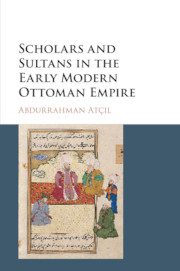Book contents
- Frontmatter
- Dedication
- Contents
- List of Tables
- Notes on Usage
- Acknowledgments
- Introduction
- Part I Scholars during the Early Ottoman Period (1300–1453)
- Part II The Formation of the Hierarchy (1453–1530)
- 3 Introducing the Ottoman Empire
- 4 Scholars in Mehmed II's Nascent Imperial Bureaucracy (1453–1481)
- 5 Scholar-Bureaucrats Realize Their Power (1481–1530)
- Part III The Consolidation of the Hierarchy (1530–1600)
- Conclusion
- Glossary
- Bibliography
- Index
3 - Introducing the Ottoman Empire
from Part II - The Formation of the Hierarchy (1453–1530)
Published online by Cambridge University Press: 24 November 2016
- Frontmatter
- Dedication
- Contents
- List of Tables
- Notes on Usage
- Acknowledgments
- Introduction
- Part I Scholars during the Early Ottoman Period (1300–1453)
- Part II The Formation of the Hierarchy (1453–1530)
- 3 Introducing the Ottoman Empire
- 4 Scholars in Mehmed II's Nascent Imperial Bureaucracy (1453–1481)
- 5 Scholar-Bureaucrats Realize Their Power (1481–1530)
- Part III The Consolidation of the Hierarchy (1530–1600)
- Conclusion
- Glossary
- Bibliography
- Index
Summary
It can be argued that from the second half of the fifteenth century through the early sixteenth, changes in governance and ideology transformed the Ottoman polity from a post-Mongol Turkmen principality into an early modern empire. In the face of the growing importance of gunpowder and a standing army of janissaries, nomadic warriors lost much of their strength. The distinguished position of the Ottoman family, especially the Ottoman sultan, became articulated. Aristocratic Turkish families became excluded from the top administrative posts. In the meantime, the bureaucratic state formation took on momentum. Viziers and commanders of slave or non-Muslim origin undertook governmental responsibilities and managed a growing bureaucracy of military and civil officials in the name of the sultan. In conjunction with all of these developments, the heads of the Ottoman political enterprise deemphasized the post-Mongol means of gaining legitimacy and power and adopted a universalist imperial ideology to project their status, power, and ambitions.
The conquest of Istanbul in 1453 seems to have catalyzed significant shifts in Ottoman governance and ideology. This success manifested the superiority of Ottoman arms over regional competitors and gradually pushed the Ottomans to the global stage. During Mehmed II's reign, the Ottomans supplemented their influence in the region by annexing the territories of or subjugating the Muslim principalities, eliminating the Byzantine control over Trabzon and the Morea and weakening the power of the Italian states in the region. They established control over Albania, Bosnia, and Serbia and marched toward Moldavia. In addition, they established a kind of suzerain control over the khans of Crimea. During the early years of Bayezid II's reign (1481–1512), although two fortresses in Kili, and Akkirman were incorporated into the Ottoman domain, overall Ottoman territorial expansion decelerated. The most important reason for this was probably the captivity of the sultan's brother, Cem Sultan (d. 1495), by the Hospitallers, the French king, and the pope in succession. The Ottomans feared that Cem's captors would force him to help them launch a crusade. Nevertheless, after Cem's death, the Ottomans began to gather a strong naval power and captured some important Venetian strongholds in the Aegean Sea. The reigns of Selim (1512–20) and Süleyman (1520–66) were marked by rapid territorial expansion. Selim incorporated eastern Anatolia, Syria, Egypt, and Arabia, while Süleyman extended the Ottoman domain in Iraq, Hungary, and North Africa.
- Type
- Chapter
- Information
- Scholars and Sultans in the Early Modern Ottoman Empire , pp. 49 - 58Publisher: Cambridge University PressPrint publication year: 2016



